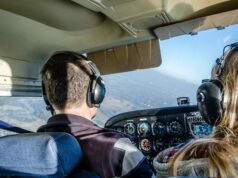It is unquestionable that the effects of density altitude could be significantly detrimental to flight safety. Following a linear correlation, an increase in density altitude leads to degraded performance. Among the many factors capable of causing loss of aircraft control and controlled flights into terrain (CFIT), density altitude is one of the most insidious, subtle and commonly overlooked elements.

Density altitude is defined as pressure altitude corrected for non-standard temperature. The dynamics of atmosphere result in fluctuations, either warmer or colder than standard, and therefor leading to instability of density altitude. As a rule of thumb, high density altitude equals poor performance. The principle can be evidenced by referencing an aircraft flight manual (AFM) or POH (pilot operating handbook). As an example, higher density altitudes always result in longer takeoff distances, as well as degraded climb rates. When departing an area of elevated terrain, the threat is maximized. The higher the altitude, the less dense the air will be. Naturally aspirated engines will not be capable of producing the same horsepower as at sea level, thus reducing the rate of climb. The importance of conducting a detailed preflight consisting of a careful evaluation of performance charts cannot be overstated. Always ensure utilizing the most appropriate chart (for a given weight, temperature and elevation) to apply all performance corrections before finalizing the calculations. The chart referenced must be specific to your aircraft make and model, not generic because each AFM is unique not only to the make and model but to the specific equipment installed on that unit.
Landing performance may also be diminished. A hot, humid day, may result in a density altitude much higher than the actual airport elevation. Combining this with a higher true airspeed and stopping may become impossible. Even before takeoff, pilots must compare actual landing distance to the runway distance available utilizing the most recent temperature data. Consider adding personal-safety margins as well, if you are operating an unfamiliar aircraft, flying from or into an unfamiliar airport or if your proficiency is degraded by a lack of recent flying.
When operating under IFR, specific departure procedures will specify the required climb gradient to remain clear of obstacles and terrain. It is possible your aircraft may be able to comply with those restrictions at lower density altitudes, but not under all other circumstances. These procedures are not able to guarantee a safe flight path if the required climb performance specified is not met. In order to prevent a controlled flight into terrain event (CFIT), a methodical and conservative approach is critical. Be aware of the aircraft’s capabilities, but most importantly, do not exceed the operating envelope or operate close to its maximum limits.
Sophisticated ground-proximity systems and terrain displays are rendered useless if an aircraft is not capable of avoiding terrain due to insufficient performance. As mere tools to enhance situational awareness, they do not replace a diligent preflight. Each flight deserves a careful examination of all environmental factors, including density altitude. Even if it appears to be insignificant on a given day, build the habit of calculating its effects on takeoff, climb, and landing performance prior to every flight. Do not allow a routine takeoff or landing to become an accident. As always, prevention starts with knowledge and discipline, including establishing personal minimums and detailed preflight inspections.





















































